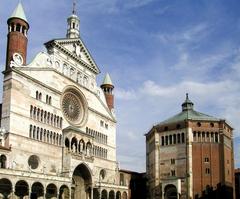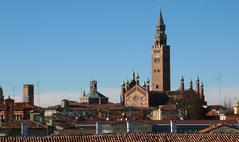
Cremona–Iseo Railway Visiting Hours, Tickets, and Travel Guide
Date: 04/07/2025
Introduction to the Cremona–Iseo Railway
The Cremona–Iseo Railway is a storied chapter in Lombardy’s transport and cultural history, offering today’s visitors an opportunity to connect with Italy’s rich regional heritage. Established in the early 20th century, this railway once linked the agricultural plains of Cremona with the vibrant industrial and alpine areas near Lake Iseo and Val Camonica. Though no longer operational in its entirety, the railway’s legacy lives on through heritage sites, museums, and cycling trails that trace its historic route (de.wikiital.com; claudiotamburini.it).
From the engineering challenges of building bridges over the Oglio River—particularly after wartime destruction—to the role the railway played in regional development and wartime logistics, the Cremona–Iseo line helped shape Lombardy’s economic and social landscape. Today, it inspires travelers to explore historical stations, visit railway museums, and enjoy special excursions like the “Treno dei Sapori,” which combines local gastronomy with scenic rail journeys.
This guide details the railway’s history, practical visitor information, ticketing, opening hours, and travel tips, ensuring you make the most of your exploration of Lombardy’s railway heritage.
Historical Overview
Origins and Early Development
The Cremona–Iseo Railway was conceived in the early 1900s to bridge Cremona’s fertile agricultural territory with the industrious and touristic regions around Lake Iseo. Driven by local authorities and the Società Nazionale Ferrovie e Tramvie (SNFT), the line filled a crucial gap in regional connectivity, complementing the Brescia–Iseo–Edolo railway (de.wikiital.com; claudiotamburini.it).
Construction and Expansion
Construction began after royal authorizations in 1912 and 1915. The railway opened in stages: Iseo–Rovato in 1911, Soncino–Soresina in 1914, and the final Cremona link in 1926. The route intersected with the Po Valley’s agricultural lands and included notable engineering feats, such as the Oglio River bridge (museo.ferrovienord.it).
Economic and Social Significance
The line contributed significantly to regional growth by facilitating the movement of agricultural goods, manufactured products, and people. It also played a social role, connecting rural and urban communities, supporting tourism, and hosting local markets and festivals at its stations (claudiotamburini.it).
Wartime Impact and Recovery
During both World Wars, the railway was crucial for troop movements and logistics. It faced major disruptions, including the destruction of infrastructure like the Oglio River bridge, which was rebuilt postwar in 1950 (de.wikiital.com; claudiotamburini.it).
Decline and Closure
Changing transport patterns in the postwar era, combined with new legislative requirements and increased competition from road vehicles, led to the gradual closure of the line. The Rovato–Soresina section ceased in 1956, replaced by bus services, and remaining segments closed soon after. Only a small part of the original route remains as part of the Brescia–Iseo–Edolo line (museo.ferrovienord.it).
The Cremona–Iseo Railway Experience Today
Heritage Sites and Museums
- Museo della Ferrovia di Rovato: Dedicated to the Brescia–Iseo–Edolo and Cremona–Iseo lines, this museum features historical artifacts, photographs, and interactive exhibits (museo.ferrovienord.it).
- Former Stations: Towns like Soncino and Soresina retain their early 20th-century railway architecture, often hosting cultural events or local tourism activities.
- Cycling and Walking Trails: Sections of the old railway have been converted to scenic trails, ideal for cycling or walking and tracing the railway’s original path.
Special Train Experiences
- Treno dei Sapori: This themed train offers a gourmet journey through Franciacorta and Lake Iseo, featuring local wine and food tastings aboard vintage carriages with panoramic windows. Advance booking is required (Treno dei Sapori).
Accessibility
Most major stations and museum sites offer step-free access and facilities for travelers with reduced mobility. Some older buildings may have limited accessibility; check with local tourism offices for details.
Practical Visitor Information
Tickets and Reservations
- Regional Trains: Tickets available at stations, online (Trenord, Trenitalia, Omio), or via mobile app. Prices range from €5–€15 depending on the route (The Savvy Backpacker; Cultured Voyages).
- Treno dei Sapori: Themed train, €50–€90 per person, includes tastings and guided activities. Book in advance (Treno dei Sapori).
- Ticket Validation: Paper tickets must be validated at platform machines before travel. E-tickets do not require validation.
Visiting Hours
- Stations: Typically open from 6:00 AM to 8:00 PM, though hours may vary by location.
- Museums: Open Tuesday–Sunday, 10:00 AM–6:00 PM; verify on official websites.
- Attractions: Cremona’s Violin Museum and Cathedral, Soncino’s fortress, and Iseo’s lakeside sites are usually open 9:00 AM–6:00 PM; check for seasonal variations.
Amenities and Onboard Facilities
- Regional Trains: Comfortable seating, air conditioning, overhead racks, toilets (may require a small fee at stations), no onboard catering (She Goes The Distance).
- Treno dei Sapori: Air conditioning, panoramic windows, multimedia systems, gourmet food and wine service.
Accessibility and Luggage
- Stations: Major stops have ramps/lifts; some minor stations may be less accessible.
- Luggage: No strict restrictions, but space can be limited during busy periods.
Route Highlights and Nearby Attractions
- Cremona: Renowned for its violin-making tradition; visit the Violin Museum and Cathedral. More on Cremona
- Soncino: Medieval fortress, charming old town; ideal for cultural walks (Claudio Tamburini).
- Soresina: Historical railway town with preserved architecture.
- Iseo: Picturesque lakeside promenade, boat trips to Monte Isola, proximity to Franciacorta vineyards (Understanding Italy).
Dining and Accommodation
- Cremona and Iseo: Wide range of restaurants and hotels. Book in advance during summer (Mama Loves Italy).
- Franciacorta Region: Famous for sparkling wines and scenic dining (Great Rail).
Seasonal Considerations and Updates
- Peak Travel: July and August are busiest; expect higher demand for tickets and accommodation.
- Strikes and Maintenance: National railway strikes may affect service (e.g., July 8, 2025). Check real-time updates on Trenitalia or Trenord and Expats Living in Rome.
- Weather: Spring and autumn offer pleasant conditions; winter can be foggy in the Po Valley.
Frequently Asked Questions (FAQ)
Q: Is the Cremona–Iseo Railway still operational?
A: The original line is no longer fully operational, but sections remain active and are incorporated into the Brescia–Iseo–Edolo line. Its legacy is preserved in museums and heritage sites.
Q: How do I buy tickets?
A: Purchase at stations, online via Trenord/Trenitalia/Omio, or through mobile apps. “Treno dei Sapori” requires advance booking.
Q: Are special guided tours available?
A: Yes, guided tours are offered by museums and local tourism offices, especially during festivals or special events.
Q: Is the railway accessible for travelers with disabilities?
A: Main stations and the “Treno dei Sapori” are accessible, but check specifics for smaller stations.
Q: Can I bring pets?
A: Pets are allowed on regular regional trains, but not on the “Treno dei Sapori” (except guide dogs).
Visual Aids and Maps
- [Insert map of the Cremona–Iseo Railway route. Alt text: “Map showing the route of the Cremona–Iseo Railway with stops at Cremona, Soncino, Soresina, and Iseo”]
- [Photo of Cremona station: “Cremona station ticket office, open 6 AM to 8 PM”]
- [Image of the Treno dei Sapori carriage: “Inside the Treno dei Sapori vintage train, featuring panoramic windows and onboard wine tasting”]
- [Scenic view of the Po Valley: “Cremona–Iseo Railway scenic journey through Lombardy”]
Internal Links
Recommendations and Visitor Summary
The Cremona–Iseo Railway stands as a testament to Lombardy’s ambition to connect its agricultural, industrial, and lakeside regions. Even after its closure, the railway’s spirit endures in preserved stations, museums, and scenic trails. Take advantage of themed journeys like the “Treno dei Sapori,” explore historical towns, and enjoy the region’s renowned food and wine. For a smooth trip, book in advance during peak months, check for travel updates, and consult local tourism offices for guided tours and event schedules (claudiotamburini.it; museo.ferrovienord.it; Treno dei Sapori; Great Rail).
Sources and Official Links
- de.wikiital.com
- claudiotamburini.it
- Great Rail
- Treno dei Sapori
- museo.ferrovienord.it
- Expats Living in Rome
Ready to dive into Lombardy’s railway heritage? Download the Audiala app for real-time updates, guided itineraries, and exclusive travel tips. Share your experience and explore more of Italy’s rich history by following our internal guides and joining the Audiala community.





